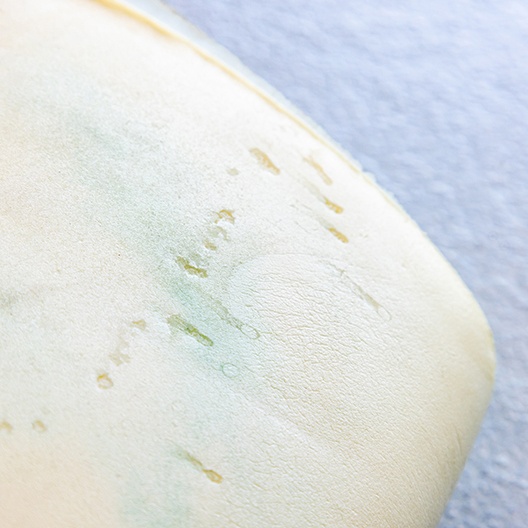
Surface disruption in flexible foam, HR foam, viscoelastic foam (automotive application)
Description:
Cells become enlarged or irregular near the surface of the foam. This is most likely to occur near the pour area and in areas where foam is less cured and more susceptible to interference.
Affected Foam Parts:
Affected are parts made of soft foam, high resilient foam, viscoelastic foam for automotive or furniture industry (headrests, armrests and cushions, as well as pillows and mattresses), acoustic foam, insulation foam and back foam.
What causes it:
Surface irregularities are often related to the release agent application: too much release agent, too high throughput, too low atomization pressure and an application that is too close to the mould are frequent causes. In addition, too low mould temperature or contamination of the foam system and compressed air affects the surface quality. Another cause can be insufficient mixing of the foam system. This results in inhomogeneities and an impairment of the surface quality. Insufficient evaporation of the release agent can also be the cause of this type of surface defect. If we can exclude above root causes, it indicates that the release agent and the PU foam are not matched to each other.
- Overapplication, too high throughput of Release Agent
- Too low atomization pressure
- Applying too close to mould surface
- Low mould temp -> Release Agent carrier doesn’t evaporate
- Contamination of foam system
- Contamination of compressed air
- Improper mixing of the foam system
Solutions:
Checking and adjusting the release agent quantity and application can remedy surface disturbances. The appropriate process parameters and the right tool temperature also help to increase surface quality.
Chem-Trend has a wide range of products that will provide a stable surface while still giving you the release you need. Our team has the knowledge to recognize these issues, isolate the source, and provide you with a solution that works.
- Check and adjust the quantity of release agent
- Check the mould temperature
- Improve release agent application
- Check PU-process parameters
- Check compressed air filters
RELATED CASE STUDIES
Chem‑Trend is the global expert in mold release agents, purging compounds, and paper impregnation chemicals, delivering innovative solutions that improve efficiency, reduce waste, and enhance manufacturing performance across diverse industries worldwide.
© 2025 Chem‑Trend L.P. or Chem‑Trend affiliated company. All rights reserved.
Regional websites:
-
Argentina
-
Brasil
(Brazil) -
Canada
-
Česko
(Czech Republic) -
CIS (excluding Russia)
-
Deutschland
(Germany) -
España
(Spain) -
France
-
India
-
Italia
(Italy) -
México
-
România
(Romania) -
Polska
(Poland) -
Türkiye
(Turkey) -
United Kingdom
-
United States
-
Việt Nam
(Vietnam) -
中国
(China) -
한국
(South Korea) -
日本
(Japan)
Notice
You are about to exit this page. You will be redirected to the Chem‑Trend Global website where you’ll find your requested content in English.
Continue